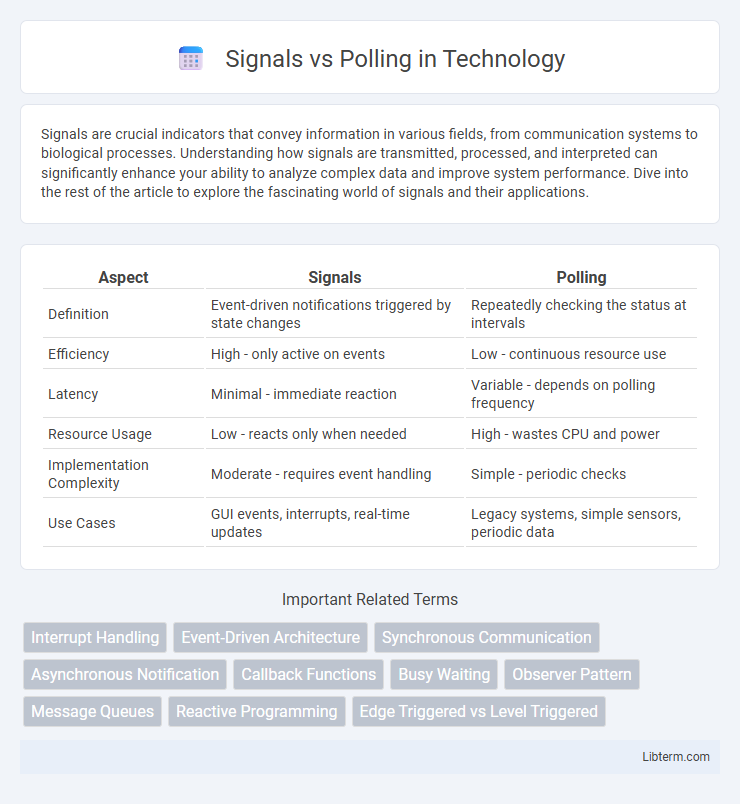Signals are crucial indicators that convey information in various fields, from communication systems to biological processes. Understanding how signals are transmitted, processed, and interpreted can significantly enhance your ability to analyze complex data and improve system performance. Dive into the rest of the article to explore the fascinating world of signals and their applications.
Table of Comparison
| Aspect | Signals | Polling |
|---|---|---|
| Definition | Event-driven notifications triggered by state changes | Repeatedly checking the status at intervals |
| Efficiency | High - only active on events | Low - continuous resource use |
| Latency | Minimal - immediate reaction | Variable - depends on polling frequency |
| Resource Usage | Low - reacts only when needed | High - wastes CPU and power |
| Implementation Complexity | Moderate - requires event handling | Simple - periodic checks |
| Use Cases | GUI events, interrupts, real-time updates | Legacy systems, simple sensors, periodic data |
Introduction to Signals and Polling
Signals and polling are fundamental techniques used in operating systems for managing asynchronous events and inter-process communication. Signals provide a mechanism for processes to receive notifications about events through software interrupts, enabling immediate response without continuous checking. Polling involves repeatedly checking the status of a resource or event, which can lead to inefficiencies due to constant CPU usage, but offers simplicity and control over the timing of checks.
What Are Signals?
Signals are asynchronous notifications sent to a process or thread to notify it of an event or condition, often used in Unix-like operating systems for inter-process communication or handling exceptions. Each signal corresponds to a specific event, such as SIGINT for interrupt or SIGTERM for termination, allowing processes to respond immediately to critical events. Signal handling enables efficient resource management and responsive program behavior without continuous checking of event states like in polling.
What Is Polling?
Polling is a technique where a processor repeatedly checks the status of an external device or condition at regular intervals to determine if attention is required. This method consumes CPU resources continuously, as the processor actively waits instead of performing other tasks. Polling is simpler to implement but less efficient compared to interrupt-driven communication, especially in systems requiring real-time responsiveness.
Key Differences Between Signals and Polling
Signals provide asynchronous notifications from the operating system to processes, allowing immediate response to specific events, while polling involves actively checking the status of a resource at regular intervals, which can lead to inefficient CPU usage. Signals are event-driven and enable interrupt-based communication, reducing latency, whereas polling relies on continuous querying, causing potential delays and increased overhead. The choice between signals and polling impacts system performance, responsiveness, and resource utilization in software applications.
Advantages of Using Signals
Signals enable efficient asynchronous event handling in operating systems by allowing processes to respond immediately to specific interrupts without continuous resource consumption. This method reduces CPU overhead compared to polling, which requires regular checking of device status, leading to faster system responsiveness and lower power usage. Signals support priority-based handling and can interrupt processes promptly, improving overall system performance and scalability.
Advantages of Using Polling
Polling offers precise control over the timing of data checks, allowing programs to manage resource allocation efficiently by initiating checks only when needed. This technique simplifies the program design by avoiding unpredictable interruptions caused by signals, enhancing stability in critical real-time applications. Polling ensures consistent system behavior by maintaining a strict execution flow, which is especially beneficial in embedded systems requiring synchronous operations.
Disadvantages of Signals
Signals have significant limitations including their asynchronous nature, which can lead to unpredictable behavior and difficulty in debugging. They may cause race conditions and lost signals if multiple signals arrive before they are handled, reducing reliability. Moreover, signal handlers are restricted in the system calls they can safely execute, limiting their functionality in complex programs.
Disadvantages of Polling
Polling consumes significant CPU resources by continuously checking the status of an event, leading to inefficient processor utilization and potential system slowdowns. This method increases power consumption, which is critical in battery-operated devices and embedded systems. Polling also introduces latency issues, as the system may miss immediate event responses compared to interrupt-driven signaling.
Signals vs Polling: Use Cases
Signals are ideal for asynchronous event handling in real-time systems, such as interrupt-driven input or hardware notifications, minimizing CPU usage by avoiding constant status checks. Polling suits scenarios requiring continuous status monitoring with predictable timing, like checking sensor states in embedded systems or user input in simple applications. Choosing between signals and polling depends on system responsiveness needs, resource constraints, and the complexity of event management.
Choosing Between Signals and Polling
Choosing between signals and polling depends on the specific application requirements and system responsiveness. Signals provide asynchronous event handling, reducing CPU usage by allowing the processor to react only when events occur, which is ideal for real-time systems. Polling involves continuously checking the status of a device or condition, offering simpler implementation but often leading to higher CPU consumption and potential latency issues.
Signals Infographic

 libterm.com
libterm.com